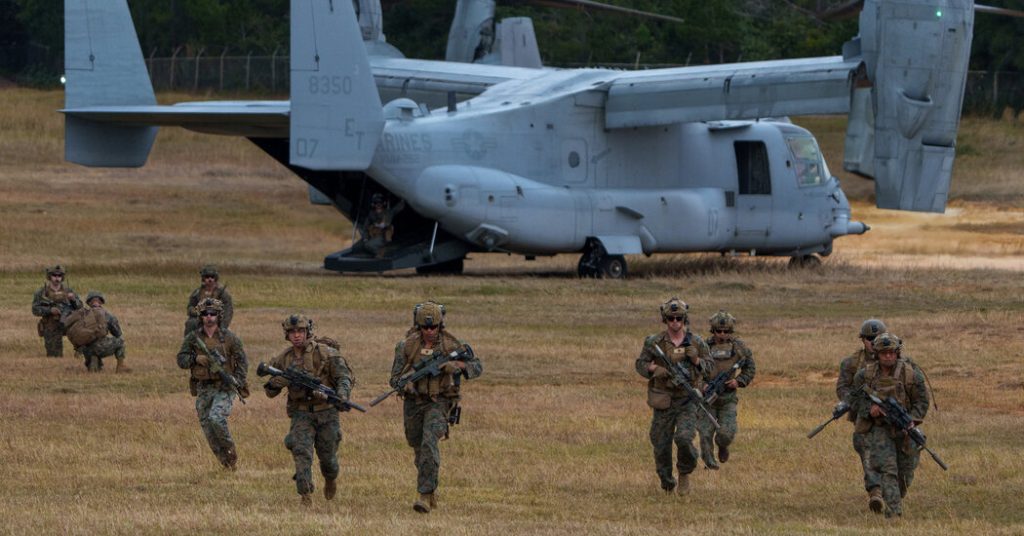Before Christmas, a contingent of 105 U.S. Marines who would have been sent to Okinawa were redirected to a new base on the United States territory of Guam instead. The small reshuffling marked a major milestone: This was the first time the Marines cut their head count on Okinawa as part of a deal between Washington and Tokyo to shrink an oversized American military presence on the Pacific island that dates back to World War II.
Under the agreement, 9,000 Marines — just under half the force currently on the island — are eventually supposed to leave. But their departure is already two decades behind the original schedule and may not happen for more than a decade to come, until construction of replacement bases is completed.
Their redeployment was agreed to in a deal signed 12 years ago, the result of negotiations and renegotiations going back to 1995, when three U.S. servicemen raped an Okinawan schoolgirl. That crime touched off mass protests that forced the United States and Japan to agree on shrinking the American bases, which were built after the United States stormed Okinawa during a bloody battle in 1945.
The first iteration of the deal, agreed upon in 1996, was supposed to reduce the burden within five to seven years by building an air base on the northern end of the island to replace an existing one in a crowded city. A generation later, the old airfield remains in use and the new one is at least 12 years from completion.
While some islanders are growing impatient, this state of constant delay seems fine with the governments of both the United States and Japan, who have a big geopolitical reason — the rise of China — for wanting to keep the Marines in place.
“So a dozen years later, only a hundred Marines have moved,” said Christopher B. Johnstone, a former director of Northeast Asia in the Office of the Secretary of Defense who helped lead U.S. negotiations of the current 2013 deal. “Both sides know things aren’t moving forward, but neither side is incentivized to take action.”
The urgency to relocate the Marines has been undermined as China has increasingly made its presence felt with military exercises. Last week, Japan’s Defense Ministry reported tracking four Chinese warships sailing between Okinawa and a nearby island.
The growing Chinese presence is felt in Tokyo and Washington, but also in Naha, the Okinawan capital, where Chinese-speaking tourists crowd Kokusai Dori, the main shopping street. Recent mayoral elections across Okinawa have been swept by conservatives who take a more favorable view of the U.S. bases as a protective presence that also supply much-needed jobs.
While anti-base demonstrations still draw hundreds of shouting protesters, many show up with walking canes. Younger Okinawans are more likely to be found at shopping malls such as the American Village, where they mingle with U.S. personnel and their families.
There are still many Okinawans who are furious at the bases. They blame Tokyo as much as Washington, saying the American presence proves that Japan still views their island — which was an independent kingdom until the 19th century — as little more than an internal colony. The current governor, Denny Tamaki, has been a leading opponent of the bases, but he and his predecessor ended up slowing down the process of reducing the American presence by refusing permits and seeking court orders to block construction of the new airfield. Last month, Japan’s Supreme Court rejected his final lawsuit, clearing the way for building to proceed.
“Keeping the bases places an excessive burden on the people of Okinawa,” said Mr. Tamaki, a former social worker whose father was a U.S. Marine. “The pressure that they put on us, in the form of crime and noise and accidents, is a type of structural discrimination.”
Still, the thinking in the two nations’ capitals has clearly shifted. When the original deal was signed, the United States was unchallenged in the western Pacific. China’s military might now puts Okinawa within easy missile range, and North Korea has also built a nuclear arsenal.
Japan would be on the front line of any conflict in Taiwan, which lies within sight of the southernmost island in the Okinawan chain. In 2022, a Chinese military exercise meant to intimidate the self-ruling island also dropped missiles into waters near Japan.
“We all recognize that the world has changed since the 1990s,” said Kevin Maher, a former U.S. diplomat who was consul-general of Okinawa. “That makes people think, ‘Oh, do the Marines actually have to start moving?’”
Still, Mr. Maher and many other American officials say the current plan remains the best option. Recent incidents like four reported sexual assaults by American servicemen last year underscore the risk of renewed anger at the U.S. bases, and Tokyo has little stomach for reopening a tortuously negotiated deal.
Japan’s prime minister, Shigeru Ishiba, repeated his commitment to the current plan during a meeting last week with President Trump, according to Japan’s foreign ministry. Mr. Ishiba has previously said that the gap left by the departing Marines could be filled by Japanese forces or joint bases.
“We will continue to work on reducing the base burden,” Mr. Ishiba said last month during the equivalent of a state-of-the-union speech. But he added that “as the balance of power in the region undergoes a historic shift, we must continue to secure the United States’ regional commitments.”
Japan is not rushing to complete the relocation, whose centerpiece remains the new airfield at Camp Schwab, a U.S. installation an hour north of the existing air base that it will replace.
The coral-filled waters off Camp Schwab are now busy with big barges, which are creating an area of landfill five times larger than the Pentagon building. V-shaped runways here will one day host helicopters and Osprey rotating-rotor airplanes, relocated from the Marine Corps Air Station Futenma in the dense residential neighborhoods in the city of Ginowan.
During a visit to Okinawa in December to mark the relocation of the first Marines, Japan’s defense minister at the time said the airfield will not be ready for use until at least 2036 — 40 years after the first agreement to build it.
The slow progress reflects Japan’s overall lack of urgency, said Hiromori Maedomari, a professor at Okinawa International University who teaches about issues raised by the military bases. “Japan wants to keep the status quo of the Marines in place as long as possible, even if that means Okinawa is expendable,” he said.
Other parts of the relocation plan are only now entering full swing.
At Camp Foster on the southern half of the island, two dozen cranes are building a new headquarters, schools and housing, part of a plan to concentrate Americans on this base, allowing other bases to close.
“It’s finally happening,” said Col. Leroy Bryant Butler, a Marine managing the building projects. “We haven’t seen this level of construction here since the 1950s, when these bases were built.”
Marines will also move to bases in Okinawa’s north, away from crowded population centers. About two-thirds of the U.S. bases in the southern part of the island will eventually be vacated, including a logistics hub filled with warehouses, a seaport and the Futenma air base.
Japan cost for the construction is about $1.5 billion a year. That’s in addition to the $2.8 billion that Tokyo spent to build a new base on Guam, Camp Blaz, which opened last month and is supposed to house about half of the Marines who leave Okinawa.
However, the Marines have made no secret of their reluctance to reduce their forces, and decline to provide a timetable. If a conflict breaks out, infantry in Guam would likely have to fight their way back to Japan against a foe who can challenge American air and sea superiority.
“Japan is now in the weapons-engagement zone,” said Wallace Gregson, a retired Marine lieutenant general who commanded the Marine force on Okinawa. “We need to change the conversation to problems that are relevant in 2025.”
Kiuko Notoya contributed reporting.








